Case Study Analysis: Jordan's Crohn's Disease - Nursing Assignment 2
VerifiedAdded on 2022/08/28
|7
|1880
|20
Case Study
AI Summary
This nursing assignment presents a case study of a 25-year-old male, Jordan James, diagnosed with Crohn's disease. The assignment addresses several key aspects of the disease, including the structural and functional changes leading to Jordan's weight loss, such as malnutrition due to inflammation, hormone changes affecting appetite, and malabsorption. It then explores the pain pathway, detailing transduction, transmission, modulation, and perception, followed by the mechanism of action of morphine in pain management. Furthermore, the assignment identifies and explains the clinical manifestations indicating the deterioration of Jordan's Crohn's condition, such as a distended abdomen, audible bowel sounds, and skin problems. Finally, it discusses the characteristics of Hartman's solution, an IV fluid, and the rationale for its administration in restoring electrolyte balance, considering the impact of mucosal inflammation on electrolyte secretion and absorption. The assignment provides a comprehensive analysis of the patient's condition, treatment, and nursing considerations.

Running head: NURSING ASSIGNMENT
Nursing Assignment
Name
Institutional Affiliation
Nursing Assignment
Name
Institutional Affiliation
Paraphrase This Document
Need a fresh take? Get an instant paraphrase of this document with our AI Paraphraser
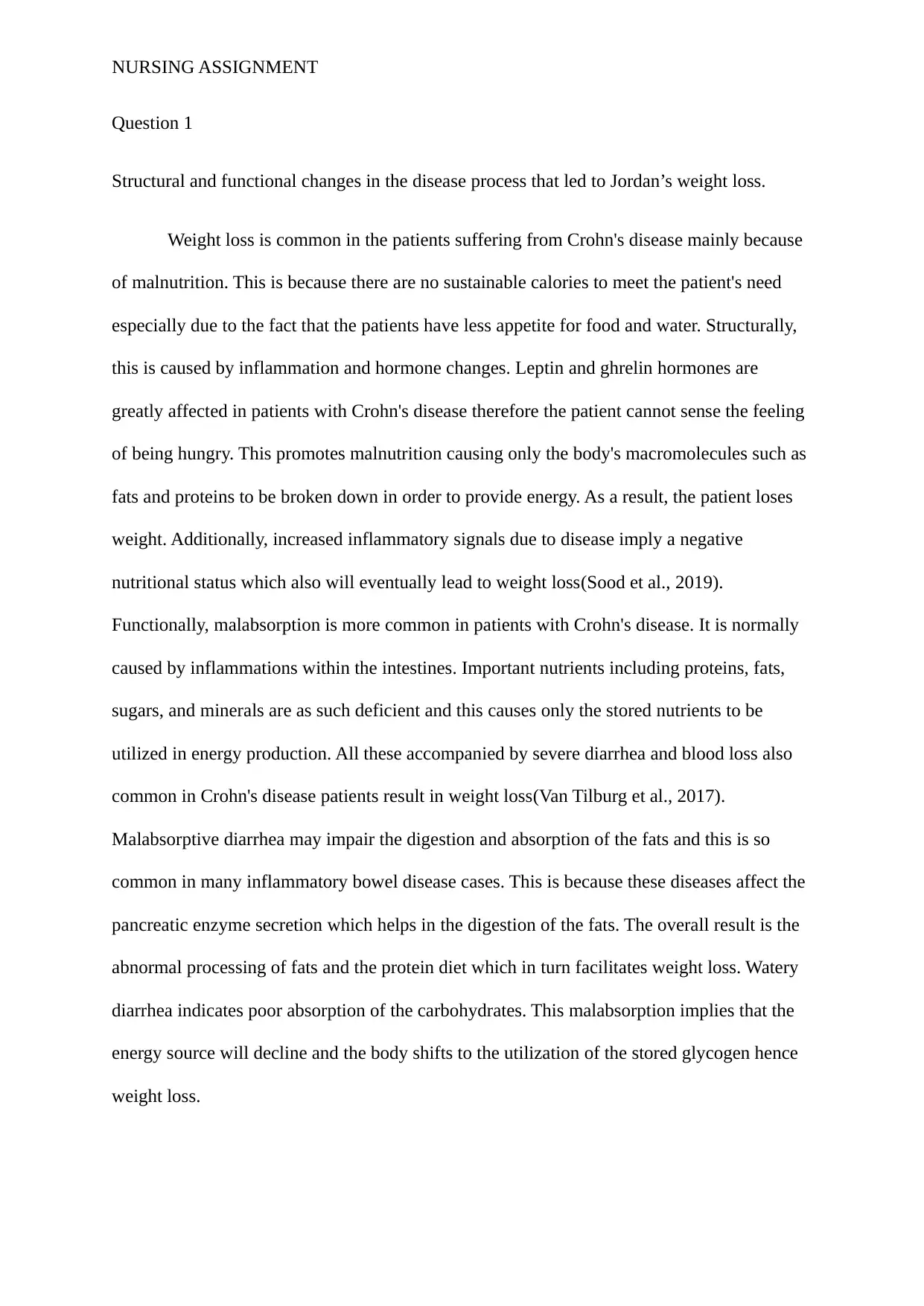
NURSING ASSIGNMENT
Question 1
Structural and functional changes in the disease process that led to Jordan’s weight loss.
Weight loss is common in the patients suffering from Crohn's disease mainly because
of malnutrition. This is because there are no sustainable calories to meet the patient's need
especially due to the fact that the patients have less appetite for food and water. Structurally,
this is caused by inflammation and hormone changes. Leptin and ghrelin hormones are
greatly affected in patients with Crohn's disease therefore the patient cannot sense the feeling
of being hungry. This promotes malnutrition causing only the body's macromolecules such as
fats and proteins to be broken down in order to provide energy. As a result, the patient loses
weight. Additionally, increased inflammatory signals due to disease imply a negative
nutritional status which also will eventually lead to weight loss(Sood et al., 2019).
Functionally, malabsorption is more common in patients with Crohn's disease. It is normally
caused by inflammations within the intestines. Important nutrients including proteins, fats,
sugars, and minerals are as such deficient and this causes only the stored nutrients to be
utilized in energy production. All these accompanied by severe diarrhea and blood loss also
common in Crohn's disease patients result in weight loss(Van Tilburg et al., 2017).
Malabsorptive diarrhea may impair the digestion and absorption of the fats and this is so
common in many inflammatory bowel disease cases. This is because these diseases affect the
pancreatic enzyme secretion which helps in the digestion of the fats. The overall result is the
abnormal processing of fats and the protein diet which in turn facilitates weight loss. Watery
diarrhea indicates poor absorption of the carbohydrates. This malabsorption implies that the
energy source will decline and the body shifts to the utilization of the stored glycogen hence
weight loss.
Question 1
Structural and functional changes in the disease process that led to Jordan’s weight loss.
Weight loss is common in the patients suffering from Crohn's disease mainly because
of malnutrition. This is because there are no sustainable calories to meet the patient's need
especially due to the fact that the patients have less appetite for food and water. Structurally,
this is caused by inflammation and hormone changes. Leptin and ghrelin hormones are
greatly affected in patients with Crohn's disease therefore the patient cannot sense the feeling
of being hungry. This promotes malnutrition causing only the body's macromolecules such as
fats and proteins to be broken down in order to provide energy. As a result, the patient loses
weight. Additionally, increased inflammatory signals due to disease imply a negative
nutritional status which also will eventually lead to weight loss(Sood et al., 2019).
Functionally, malabsorption is more common in patients with Crohn's disease. It is normally
caused by inflammations within the intestines. Important nutrients including proteins, fats,
sugars, and minerals are as such deficient and this causes only the stored nutrients to be
utilized in energy production. All these accompanied by severe diarrhea and blood loss also
common in Crohn's disease patients result in weight loss(Van Tilburg et al., 2017).
Malabsorptive diarrhea may impair the digestion and absorption of the fats and this is so
common in many inflammatory bowel disease cases. This is because these diseases affect the
pancreatic enzyme secretion which helps in the digestion of the fats. The overall result is the
abnormal processing of fats and the protein diet which in turn facilitates weight loss. Watery
diarrhea indicates poor absorption of the carbohydrates. This malabsorption implies that the
energy source will decline and the body shifts to the utilization of the stored glycogen hence
weight loss.
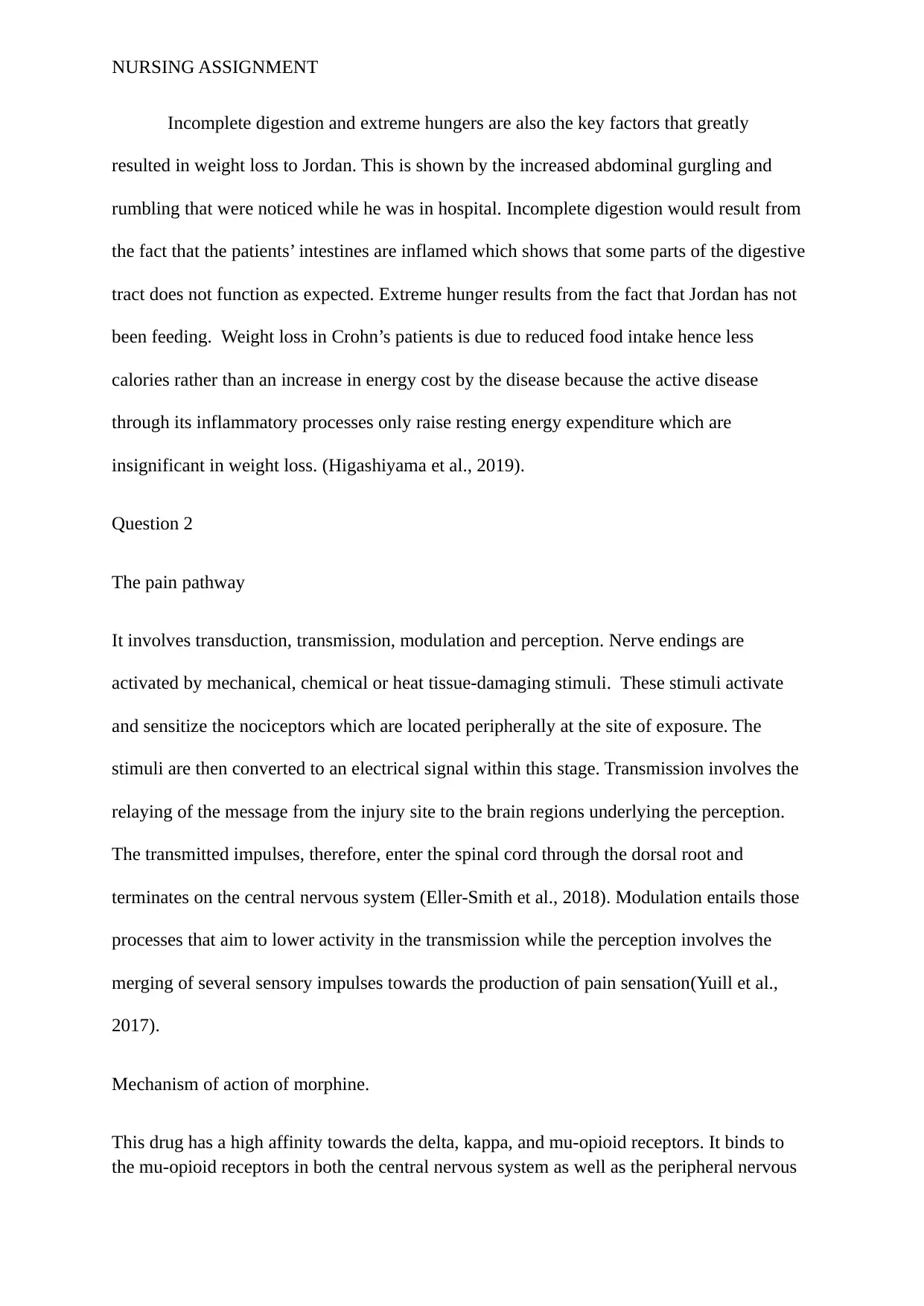
NURSING ASSIGNMENT
Incomplete digestion and extreme hungers are also the key factors that greatly
resulted in weight loss to Jordan. This is shown by the increased abdominal gurgling and
rumbling that were noticed while he was in hospital. Incomplete digestion would result from
the fact that the patients’ intestines are inflamed which shows that some parts of the digestive
tract does not function as expected. Extreme hunger results from the fact that Jordan has not
been feeding. Weight loss in Crohn’s patients is due to reduced food intake hence less
calories rather than an increase in energy cost by the disease because the active disease
through its inflammatory processes only raise resting energy expenditure which are
insignificant in weight loss. (Higashiyama et al., 2019).
Question 2
The pain pathway
It involves transduction, transmission, modulation and perception. Nerve endings are
activated by mechanical, chemical or heat tissue-damaging stimuli. These stimuli activate
and sensitize the nociceptors which are located peripherally at the site of exposure. The
stimuli are then converted to an electrical signal within this stage. Transmission involves the
relaying of the message from the injury site to the brain regions underlying the perception.
The transmitted impulses, therefore, enter the spinal cord through the dorsal root and
terminates on the central nervous system (Eller-Smith et al., 2018). Modulation entails those
processes that aim to lower activity in the transmission while the perception involves the
merging of several sensory impulses towards the production of pain sensation(Yuill et al.,
2017).
Mechanism of action of morphine.
This drug has a high affinity towards the delta, kappa, and mu-opioid receptors. It binds to
the mu-opioid receptors in both the central nervous system as well as the peripheral nervous
Incomplete digestion and extreme hungers are also the key factors that greatly
resulted in weight loss to Jordan. This is shown by the increased abdominal gurgling and
rumbling that were noticed while he was in hospital. Incomplete digestion would result from
the fact that the patients’ intestines are inflamed which shows that some parts of the digestive
tract does not function as expected. Extreme hunger results from the fact that Jordan has not
been feeding. Weight loss in Crohn’s patients is due to reduced food intake hence less
calories rather than an increase in energy cost by the disease because the active disease
through its inflammatory processes only raise resting energy expenditure which are
insignificant in weight loss. (Higashiyama et al., 2019).
Question 2
The pain pathway
It involves transduction, transmission, modulation and perception. Nerve endings are
activated by mechanical, chemical or heat tissue-damaging stimuli. These stimuli activate
and sensitize the nociceptors which are located peripherally at the site of exposure. The
stimuli are then converted to an electrical signal within this stage. Transmission involves the
relaying of the message from the injury site to the brain regions underlying the perception.
The transmitted impulses, therefore, enter the spinal cord through the dorsal root and
terminates on the central nervous system (Eller-Smith et al., 2018). Modulation entails those
processes that aim to lower activity in the transmission while the perception involves the
merging of several sensory impulses towards the production of pain sensation(Yuill et al.,
2017).
Mechanism of action of morphine.
This drug has a high affinity towards the delta, kappa, and mu-opioid receptors. It binds to
the mu-opioid receptors in both the central nervous system as well as the peripheral nervous
⊘ This is a preview!⊘
Do you want full access?
Subscribe today to unlock all pages.

Trusted by 1+ million students worldwide
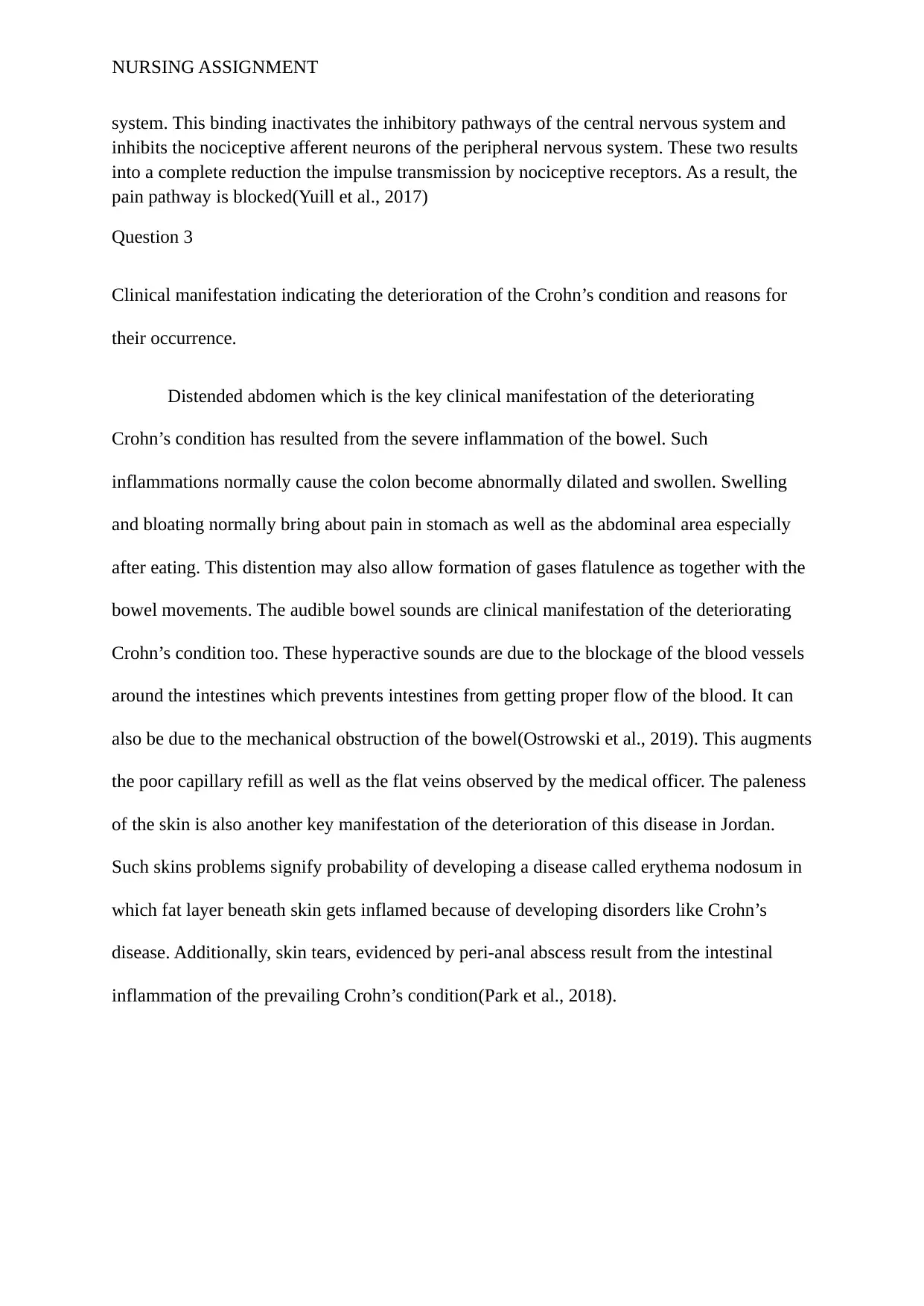
NURSING ASSIGNMENT
system. This binding inactivates the inhibitory pathways of the central nervous system and
inhibits the nociceptive afferent neurons of the peripheral nervous system. These two results
into a complete reduction the impulse transmission by nociceptive receptors. As a result, the
pain pathway is blocked(Yuill et al., 2017)
Question 3
Clinical manifestation indicating the deterioration of the Crohn’s condition and reasons for
their occurrence.
Distended abdomen which is the key clinical manifestation of the deteriorating
Crohn’s condition has resulted from the severe inflammation of the bowel. Such
inflammations normally cause the colon become abnormally dilated and swollen. Swelling
and bloating normally bring about pain in stomach as well as the abdominal area especially
after eating. This distention may also allow formation of gases flatulence as together with the
bowel movements. The audible bowel sounds are clinical manifestation of the deteriorating
Crohn’s condition too. These hyperactive sounds are due to the blockage of the blood vessels
around the intestines which prevents intestines from getting proper flow of the blood. It can
also be due to the mechanical obstruction of the bowel(Ostrowski et al., 2019). This augments
the poor capillary refill as well as the flat veins observed by the medical officer. The paleness
of the skin is also another key manifestation of the deterioration of this disease in Jordan.
Such skins problems signify probability of developing a disease called erythema nodosum in
which fat layer beneath skin gets inflamed because of developing disorders like Crohn’s
disease. Additionally, skin tears, evidenced by peri-anal abscess result from the intestinal
inflammation of the prevailing Crohn’s condition(Park et al., 2018).
system. This binding inactivates the inhibitory pathways of the central nervous system and
inhibits the nociceptive afferent neurons of the peripheral nervous system. These two results
into a complete reduction the impulse transmission by nociceptive receptors. As a result, the
pain pathway is blocked(Yuill et al., 2017)
Question 3
Clinical manifestation indicating the deterioration of the Crohn’s condition and reasons for
their occurrence.
Distended abdomen which is the key clinical manifestation of the deteriorating
Crohn’s condition has resulted from the severe inflammation of the bowel. Such
inflammations normally cause the colon become abnormally dilated and swollen. Swelling
and bloating normally bring about pain in stomach as well as the abdominal area especially
after eating. This distention may also allow formation of gases flatulence as together with the
bowel movements. The audible bowel sounds are clinical manifestation of the deteriorating
Crohn’s condition too. These hyperactive sounds are due to the blockage of the blood vessels
around the intestines which prevents intestines from getting proper flow of the blood. It can
also be due to the mechanical obstruction of the bowel(Ostrowski et al., 2019). This augments
the poor capillary refill as well as the flat veins observed by the medical officer. The paleness
of the skin is also another key manifestation of the deterioration of this disease in Jordan.
Such skins problems signify probability of developing a disease called erythema nodosum in
which fat layer beneath skin gets inflamed because of developing disorders like Crohn’s
disease. Additionally, skin tears, evidenced by peri-anal abscess result from the intestinal
inflammation of the prevailing Crohn’s condition(Park et al., 2018).
Paraphrase This Document
Need a fresh take? Get an instant paraphrase of this document with our AI Paraphraser
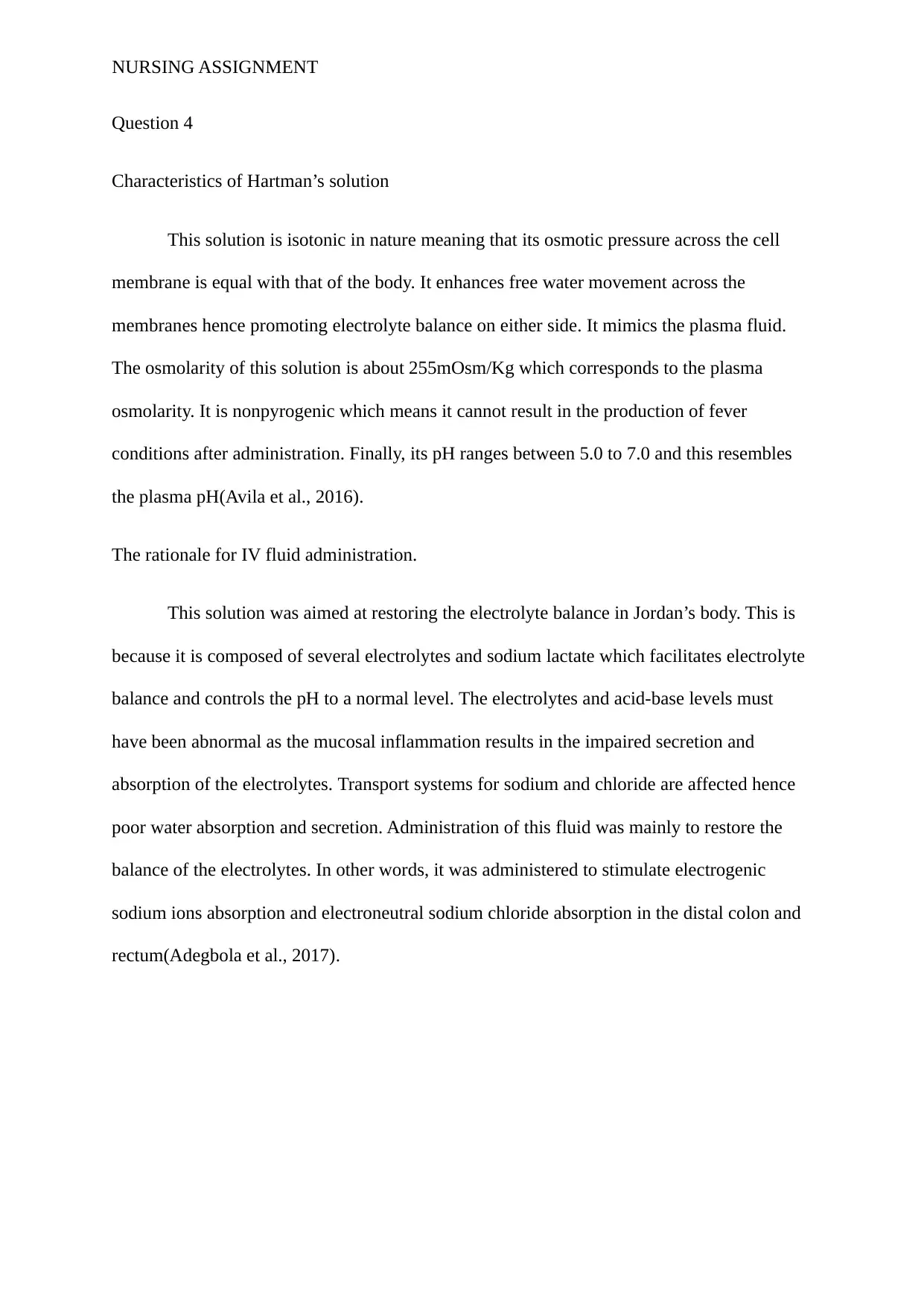
NURSING ASSIGNMENT
Question 4
Characteristics of Hartman’s solution
This solution is isotonic in nature meaning that its osmotic pressure across the cell
membrane is equal with that of the body. It enhances free water movement across the
membranes hence promoting electrolyte balance on either side. It mimics the plasma fluid.
The osmolarity of this solution is about 255mOsm/Kg which corresponds to the plasma
osmolarity. It is nonpyrogenic which means it cannot result in the production of fever
conditions after administration. Finally, its pH ranges between 5.0 to 7.0 and this resembles
the plasma pH(Avila et al., 2016).
The rationale for IV fluid administration.
This solution was aimed at restoring the electrolyte balance in Jordan’s body. This is
because it is composed of several electrolytes and sodium lactate which facilitates electrolyte
balance and controls the pH to a normal level. The electrolytes and acid-base levels must
have been abnormal as the mucosal inflammation results in the impaired secretion and
absorption of the electrolytes. Transport systems for sodium and chloride are affected hence
poor water absorption and secretion. Administration of this fluid was mainly to restore the
balance of the electrolytes. In other words, it was administered to stimulate electrogenic
sodium ions absorption and electroneutral sodium chloride absorption in the distal colon and
rectum(Adegbola et al., 2017).
Question 4
Characteristics of Hartman’s solution
This solution is isotonic in nature meaning that its osmotic pressure across the cell
membrane is equal with that of the body. It enhances free water movement across the
membranes hence promoting electrolyte balance on either side. It mimics the plasma fluid.
The osmolarity of this solution is about 255mOsm/Kg which corresponds to the plasma
osmolarity. It is nonpyrogenic which means it cannot result in the production of fever
conditions after administration. Finally, its pH ranges between 5.0 to 7.0 and this resembles
the plasma pH(Avila et al., 2016).
The rationale for IV fluid administration.
This solution was aimed at restoring the electrolyte balance in Jordan’s body. This is
because it is composed of several electrolytes and sodium lactate which facilitates electrolyte
balance and controls the pH to a normal level. The electrolytes and acid-base levels must
have been abnormal as the mucosal inflammation results in the impaired secretion and
absorption of the electrolytes. Transport systems for sodium and chloride are affected hence
poor water absorption and secretion. Administration of this fluid was mainly to restore the
balance of the electrolytes. In other words, it was administered to stimulate electrogenic
sodium ions absorption and electroneutral sodium chloride absorption in the distal colon and
rectum(Adegbola et al., 2017).
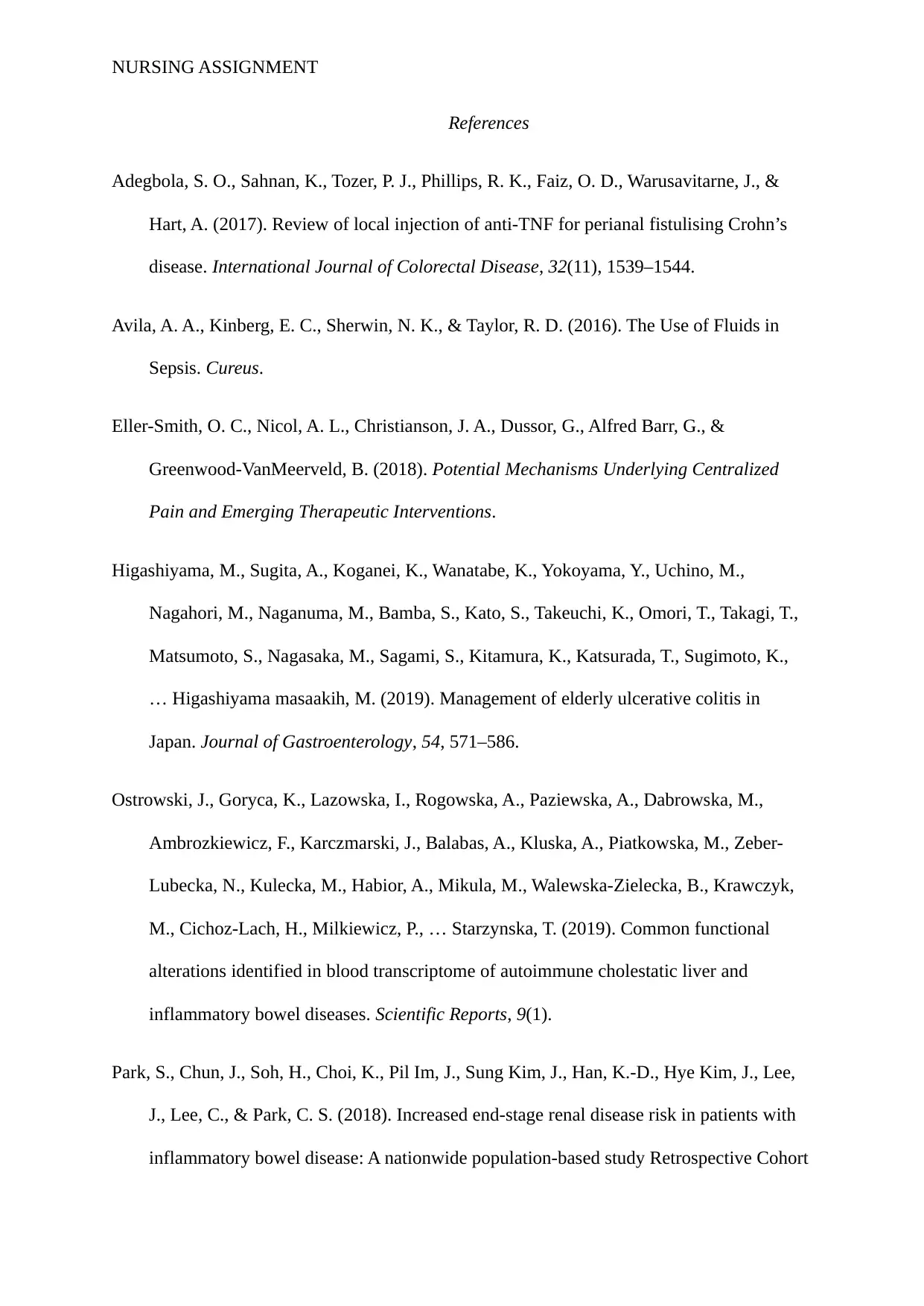
NURSING ASSIGNMENT
References
Adegbola, S. O., Sahnan, K., Tozer, P. J., Phillips, R. K., Faiz, O. D., Warusavitarne, J., &
Hart, A. (2017). Review of local injection of anti-TNF for perianal fistulising Crohn’s
disease. International Journal of Colorectal Disease, 32(11), 1539–1544.
Avila, A. A., Kinberg, E. C., Sherwin, N. K., & Taylor, R. D. (2016). The Use of Fluids in
Sepsis. Cureus.
Eller-Smith, O. C., Nicol, A. L., Christianson, J. A., Dussor, G., Alfred Barr, G., &
Greenwood-VanMeerveld, B. (2018). Potential Mechanisms Underlying Centralized
Pain and Emerging Therapeutic Interventions.
Higashiyama, M., Sugita, A., Koganei, K., Wanatabe, K., Yokoyama, Y., Uchino, M.,
Nagahori, M., Naganuma, M., Bamba, S., Kato, S., Takeuchi, K., Omori, T., Takagi, T.,
Matsumoto, S., Nagasaka, M., Sagami, S., Kitamura, K., Katsurada, T., Sugimoto, K.,
… Higashiyama masaakih, M. (2019). Management of elderly ulcerative colitis in
Japan. Journal of Gastroenterology, 54, 571–586.
Ostrowski, J., Goryca, K., Lazowska, I., Rogowska, A., Paziewska, A., Dabrowska, M.,
Ambrozkiewicz, F., Karczmarski, J., Balabas, A., Kluska, A., Piatkowska, M., Zeber-
Lubecka, N., Kulecka, M., Habior, A., Mikula, M., Walewska-Zielecka, B., Krawczyk,
M., Cichoz-Lach, H., Milkiewicz, P., … Starzynska, T. (2019). Common functional
alterations identified in blood transcriptome of autoimmune cholestatic liver and
inflammatory bowel diseases. Scientific Reports, 9(1).
Park, S., Chun, J., Soh, H., Choi, K., Pil Im, J., Sung Kim, J., Han, K.-D., Hye Kim, J., Lee,
J., Lee, C., & Park, C. S. (2018). Increased end-stage renal disease risk in patients with
inflammatory bowel disease: A nationwide population-based study Retrospective Cohort
References
Adegbola, S. O., Sahnan, K., Tozer, P. J., Phillips, R. K., Faiz, O. D., Warusavitarne, J., &
Hart, A. (2017). Review of local injection of anti-TNF for perianal fistulising Crohn’s
disease. International Journal of Colorectal Disease, 32(11), 1539–1544.
Avila, A. A., Kinberg, E. C., Sherwin, N. K., & Taylor, R. D. (2016). The Use of Fluids in
Sepsis. Cureus.
Eller-Smith, O. C., Nicol, A. L., Christianson, J. A., Dussor, G., Alfred Barr, G., &
Greenwood-VanMeerveld, B. (2018). Potential Mechanisms Underlying Centralized
Pain and Emerging Therapeutic Interventions.
Higashiyama, M., Sugita, A., Koganei, K., Wanatabe, K., Yokoyama, Y., Uchino, M.,
Nagahori, M., Naganuma, M., Bamba, S., Kato, S., Takeuchi, K., Omori, T., Takagi, T.,
Matsumoto, S., Nagasaka, M., Sagami, S., Kitamura, K., Katsurada, T., Sugimoto, K.,
… Higashiyama masaakih, M. (2019). Management of elderly ulcerative colitis in
Japan. Journal of Gastroenterology, 54, 571–586.
Ostrowski, J., Goryca, K., Lazowska, I., Rogowska, A., Paziewska, A., Dabrowska, M.,
Ambrozkiewicz, F., Karczmarski, J., Balabas, A., Kluska, A., Piatkowska, M., Zeber-
Lubecka, N., Kulecka, M., Habior, A., Mikula, M., Walewska-Zielecka, B., Krawczyk,
M., Cichoz-Lach, H., Milkiewicz, P., … Starzynska, T. (2019). Common functional
alterations identified in blood transcriptome of autoimmune cholestatic liver and
inflammatory bowel diseases. Scientific Reports, 9(1).
Park, S., Chun, J., Soh, H., Choi, K., Pil Im, J., Sung Kim, J., Han, K.-D., Hye Kim, J., Lee,
J., Lee, C., & Park, C. S. (2018). Increased end-stage renal disease risk in patients with
inflammatory bowel disease: A nationwide population-based study Retrospective Cohort
⊘ This is a preview!⊘
Do you want full access?
Subscribe today to unlock all pages.

Trusted by 1+ million students worldwide
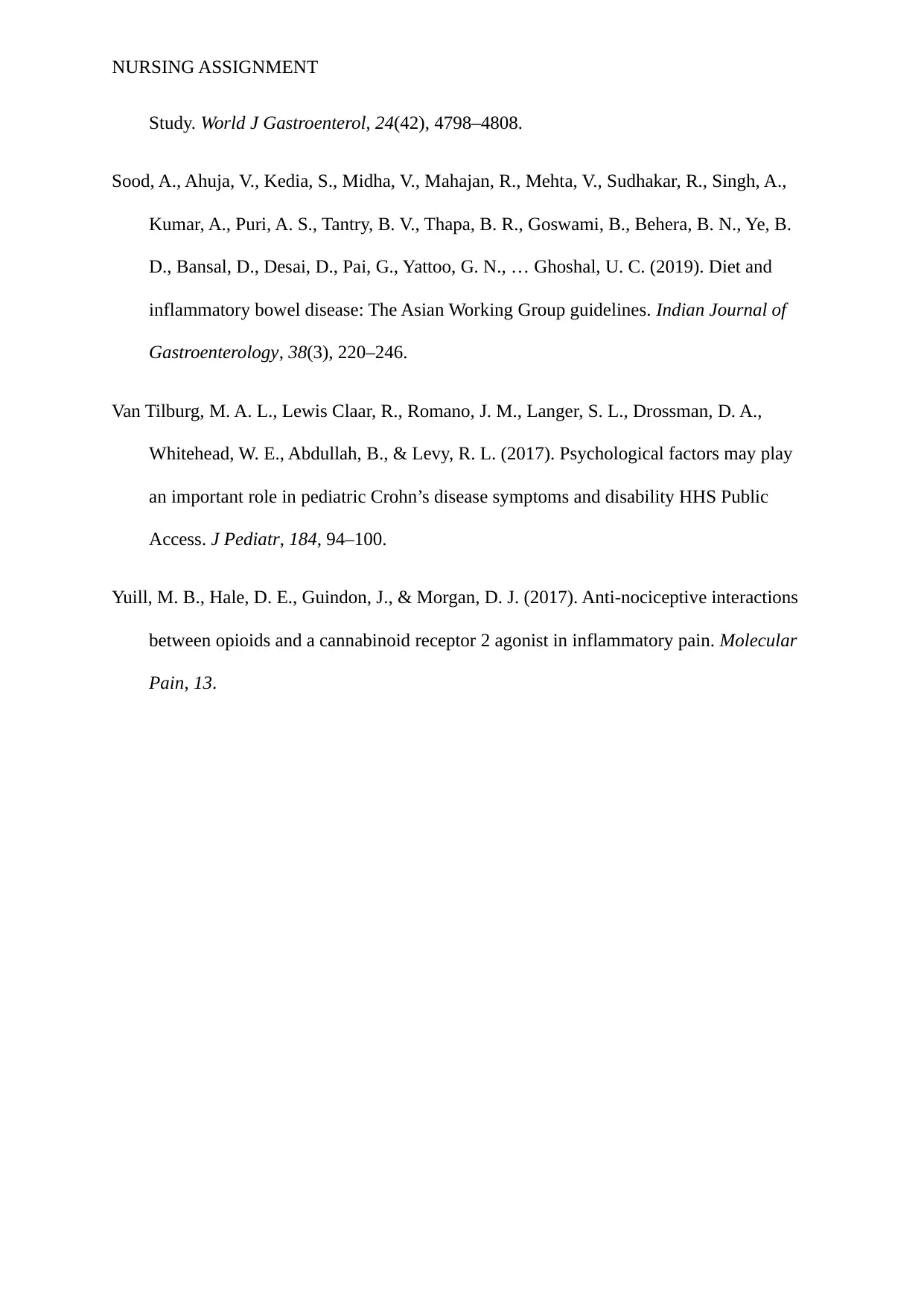
NURSING ASSIGNMENT
Study. World J Gastroenterol, 24(42), 4798–4808.
Sood, A., Ahuja, V., Kedia, S., Midha, V., Mahajan, R., Mehta, V., Sudhakar, R., Singh, A.,
Kumar, A., Puri, A. S., Tantry, B. V., Thapa, B. R., Goswami, B., Behera, B. N., Ye, B.
D., Bansal, D., Desai, D., Pai, G., Yattoo, G. N., … Ghoshal, U. C. (2019). Diet and
inflammatory bowel disease: The Asian Working Group guidelines. Indian Journal of
Gastroenterology, 38(3), 220–246.
Van Tilburg, M. A. L., Lewis Claar, R., Romano, J. M., Langer, S. L., Drossman, D. A.,
Whitehead, W. E., Abdullah, B., & Levy, R. L. (2017). Psychological factors may play
an important role in pediatric Crohn’s disease symptoms and disability HHS Public
Access. J Pediatr, 184, 94–100.
Yuill, M. B., Hale, D. E., Guindon, J., & Morgan, D. J. (2017). Anti-nociceptive interactions
between opioids and a cannabinoid receptor 2 agonist in inflammatory pain. Molecular
Pain, 13.
Study. World J Gastroenterol, 24(42), 4798–4808.
Sood, A., Ahuja, V., Kedia, S., Midha, V., Mahajan, R., Mehta, V., Sudhakar, R., Singh, A.,
Kumar, A., Puri, A. S., Tantry, B. V., Thapa, B. R., Goswami, B., Behera, B. N., Ye, B.
D., Bansal, D., Desai, D., Pai, G., Yattoo, G. N., … Ghoshal, U. C. (2019). Diet and
inflammatory bowel disease: The Asian Working Group guidelines. Indian Journal of
Gastroenterology, 38(3), 220–246.
Van Tilburg, M. A. L., Lewis Claar, R., Romano, J. M., Langer, S. L., Drossman, D. A.,
Whitehead, W. E., Abdullah, B., & Levy, R. L. (2017). Psychological factors may play
an important role in pediatric Crohn’s disease symptoms and disability HHS Public
Access. J Pediatr, 184, 94–100.
Yuill, M. B., Hale, D. E., Guindon, J., & Morgan, D. J. (2017). Anti-nociceptive interactions
between opioids and a cannabinoid receptor 2 agonist in inflammatory pain. Molecular
Pain, 13.
1 out of 7
Related Documents
Your All-in-One AI-Powered Toolkit for Academic Success.
+13062052269
info@desklib.com
Available 24*7 on WhatsApp / Email
![[object Object]](/_next/static/media/star-bottom.7253800d.svg)
Unlock your academic potential
Copyright © 2020–2025 A2Z Services. All Rights Reserved. Developed and managed by ZUCOL.





